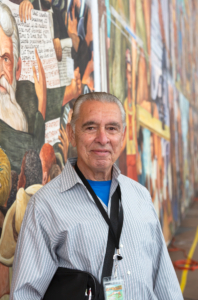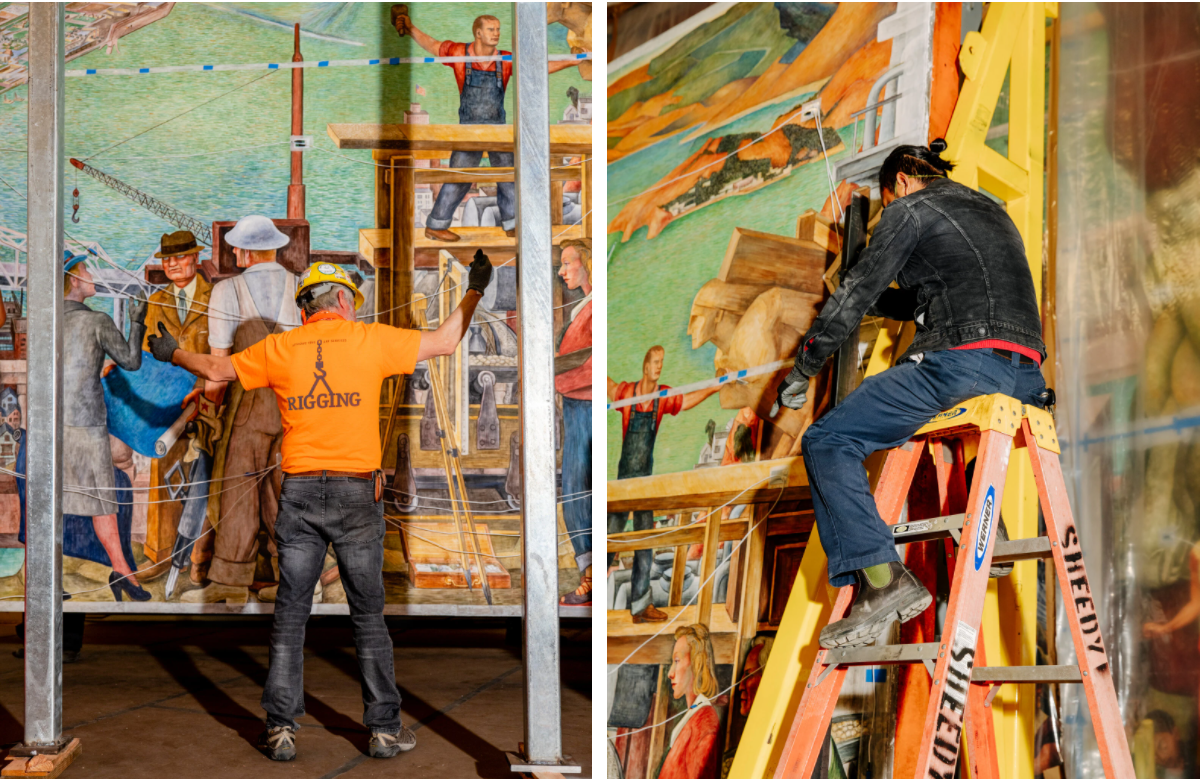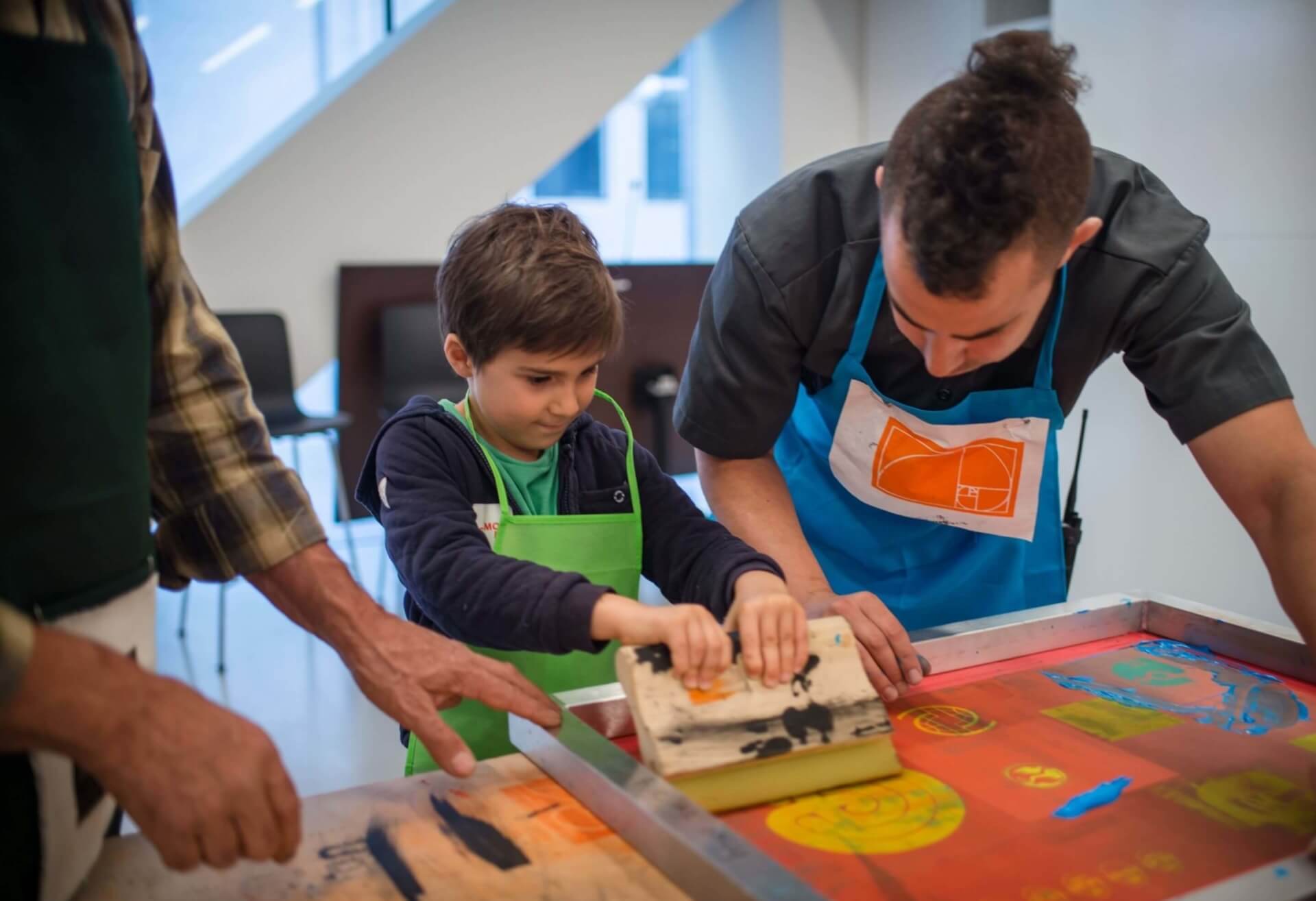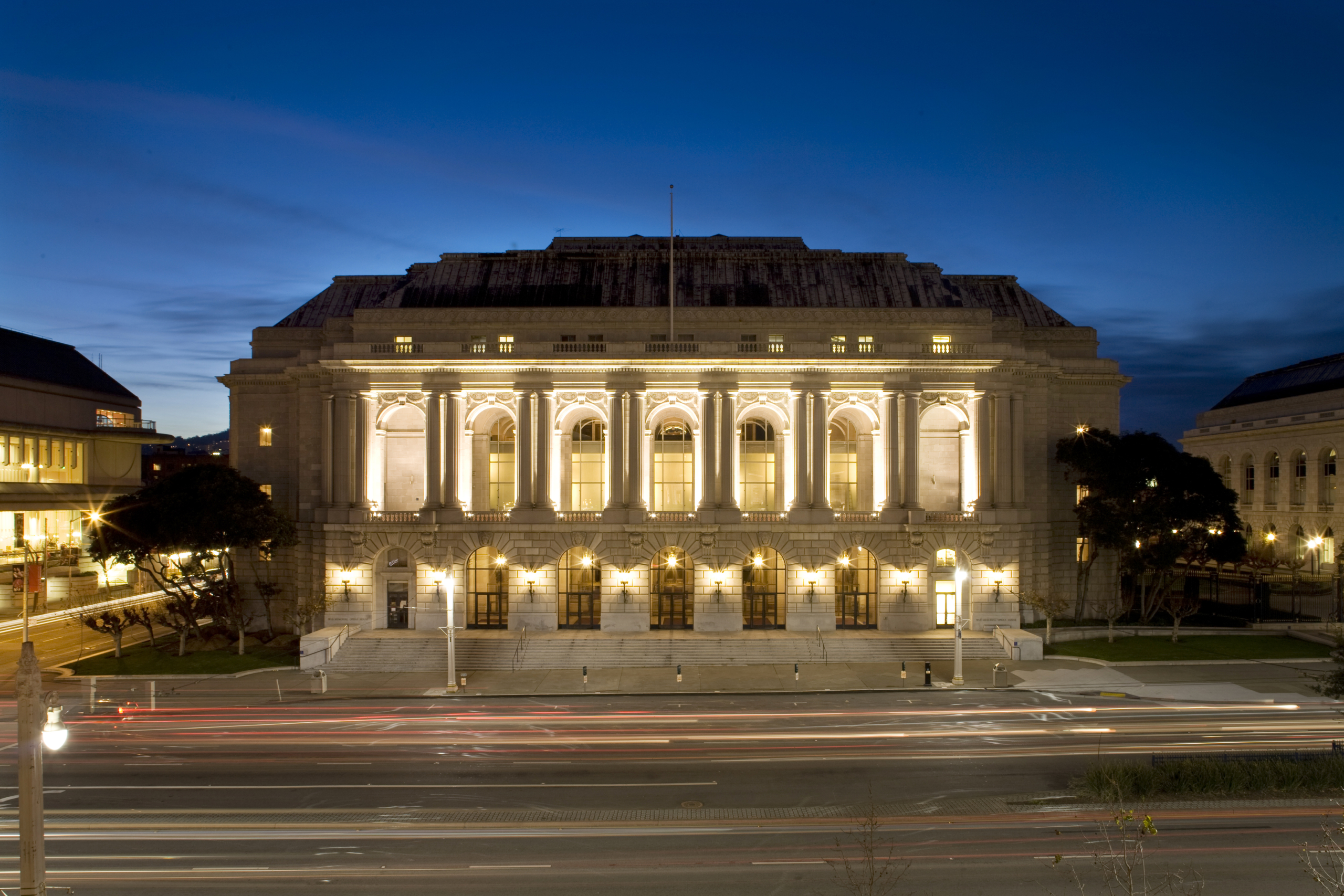Pan American Unity: Diego Rivera’s monumental mural at SFMOMA
Pan American Unity: Diego Rivera’s monumental mural at SFMOMA
Diego Rivera’s mural Pan American Unity is monumental both in size—22 ft. tall by 74 ft. wide—and in scope. Its full title sums up the epic perspective of the story Rivera set out to depict in 1940: The Marriage of the Artistic Expression of the North and of the South on This Continent. The mural, owned by City College of San Francisco (CCSF), has been on exhibit at the San Francisco Museum of Modern Art (SFMOMA) since June of 2021.
How the 30-ton mural travelled seven miles from the college to the museum is its own saga. The Koret Foundation was honored to fund the complex undertaking, which required de-installation, conservation, and meticulous documentation, to ensure safe transportation and installation. To date, the mural has been enjoyed by more than 600,000 people since the exhibition opened on June 28, 2021. It will remain on view through January, 2024.
Pan-American Unity
Diego Rivera's largest contiguous mural
1940
Diego Rivera completes his mural on Treasure Island after 4 months of work
Total weight in pounds of the installation
60,000
Square footage of the mural
1,628
Details of the monumental mural
Panels in the mural
10
Representations of Diego Rivera in the mural
3
Representations of Frida Kahlo, Hitler, Stalin, and Mussolini in the mural
1

Hundreds of visitors come to view Pan American Unity every day, and many of them have “toured” with Will Maynez, widely considered the mural’s custodio, or guardian. Most weeks, he spends five afternoons at SFMOMA in his ad hoc capacity as the masterpiece’s historian, guide, and storyteller. He has been the mural’s ardent champion since 1997, collecting, analyzing, and organizing information on Diego Rivera’s visits to San Francisco. We had several chances to chat with Maynez about the artist and the mural. He is perpetually delighted to start at the beginning: “Diego was building a metaphoric bridge between the Mexican culture and the tech culture of the United States.”
It is uplifting, even inspiring, to reflect on what exhibiting the mural at SFMOMA has meant, not only for museum visitors from around the world, but also for the museum’s staff, for San Francisco, and for the future of art scholarship and collaboration. The entire undertaking itself has been a remarkable example of Pan-American unity on a monumental scale, a literal confluence of cultural traditions and technology.
Diego Rivera’s masterpiece
In 1940, Diego Rivera was commissioned to paint a mural at the Golden Gate International Exposition on Treasure Island, in San Francisco Bay. He worked on scaffolding, with the bottom of the mural-in-progress 14 feet above the floor. Fairgoers could observe Rivera painting directly on that day’s wet plaster (known as a giornata), barely more than 1 inch thick. The mural was intended to be installed at City College of San Francisco (CCSF), in the school’s new library. But World War II precluded the building’s construction, and the panels were put in storage for 20 years. Ultimately, the mural was installed in the lobby of the college’s Diego Rivera Theater, where it stayed for 60 years. When CCSF began planning for a new performing arts building, rather than seismically retrofitting the existing theater, an elephantine question loomed: What about the mural?
Diego Rivera needed four months to paint Pan American Unity. Almost eight decades later, a cast of experts—art conservators, fresco scholars, logistics crews, and other specialists in the Bay Area and Mexico City—would need four years to collaborate on safely moving the mural.
CCSF’s stewardship
In 1999, CCSF engaged Francesca Piqué, a Florentine art conservator from the Getty Conservation Institute, to perform a one-day assessment of the mural’s condition. Maynez recalls, “I spent the day with Francesca, and she changed my life when she told me that we should think about taking care of the mural for the next 200 years.” In 2011, CCSF signed a memorandum of understanding with the Mexican Consulate, pledging cooperation in the stewardship of “a treasure of two countries,” a mural which can last centuries.
CCSF is planning to build a new performing arts center, appropriately named the Diego Rivera Theater. The new center will enable to school to expand its dramatic arts programs, and will become the permanent home of Pan American Unity, installed at optimal viewing height and visible from the exterior. To accomplish the ambitious next phase in the mural’s life, CCSF and SFMOMA formed a multifaceted partnership, formalizing ambitious goals to conserve the mural, display it prominently, provide internships for CCSF students, and focus major media attention on the mural.
What drew the Foundation to the project were the unique educational opportunities the endeavor presented. Koret is a long-time funder both of SFMOMA and of arts education throughout the Bay Area. Funding these particular internships aligned with the Foundation’s education initiatives, while providing CCSF a pathway for the next generation of art historians and curators to shape new artistic practices in real time.
SFMOMA hired six CCSF students to support research and planning as the team prepped the mural for the intricate move from the college to the museum. The interns supported the activities of three SFMOMA departments: Painting & Sculpture, Library & Archives, and Conservation. Collectively, their work generated invaluable new knowledge about Diego Rivera and the mural, providing resources at CCSF that the museum might not have otherwise been able to access, including archival materials housed within the Rosenberg Library. The interns also served as a conduit between SFMOMA staff and City College, as the students were deeply rooted in their system.
Collaboration
Working together to ensure the mural's future: SFMOMA, CCSF, Koret, and Universidad Nacional Autónoma de México
2017
Koret enters into a three-year partnership with CCSF to de-install, conserve, transport, and install the mural at SFMOMA
Visitors as of August 2023
610,000
Afternoons that Will Maynez has spent at SFMOMA giving tours
500+
A labor of love: of art, of history, of community
MPH: the speed of the trucks moving the mural panels from CCSF to SFMOMA
5
Dollars in ticket sales to see the mural at SFMOMA
0
SFMOMA’s Rivera connection
In 1940, the museum’s founding director, Grace McCann Morley, was key to bringing Diego Rivera to the Golden Gate International Exposition to paint the mural. Additionally, Albert Bender, a patron of Rivera and a museum trustee, was a foundational donor of the artist’s work to the museum’s collection. Fast forward to 2017, when Neil Benezra, then director of SFMOMA, promised that Pan American Unity “would never be little known again.” How fitting that the mural is having a season in the spotlight at the institution whose guiding lights have championed his work for over 80 years.
The SFMOMA team was deeply involved in the conservation work done for the move, which will help ensure the mural’s future. The team’s approach also set the stage for extraordinary cooperation between the museum and fresco specialists at Universidad Nacional Autónoma de México (UNAM) in Mexico City. The city is Rivera’s artistic home turf, with five of his murals permanently displayed in public spaces and many smaller works in museums. Maynez, who is Mexican American, accompanied the SFMOMA team on their first visit to UNAM, and confirms, “Mexico’s participation in the mural move will never be underestimated by those who worked on the project. The expertise UNAM provided remotely—number crunching, computer modeling, and constructing a pair of full-size mural panel replicas—delivered the hard data to guide the handling and transporting of the precious art.” The UNAM team travelled to San Francisco to oversee the painstaking move of the mural panels by flatbed truck, closely monitoring the movement and vibrations in order to keep the artwork stable and safe.
The community’s involvement
The museum developed an array of free public programs, many of which were available for audiences of all ages, to accompany Pan American Unity. To celebrate San Francisco’s vibrant contemporary mural scene, which had begun in the early 1970s in the Mission District, SFMOMA collaborated with community partners Acción Latina, NIAD Art Center, and SOMA Pilipinas to celebrate Pan American Unity. The Mini Murals Festival welcomed 3,500 people over three weekends of events. SFMOMA invited each partner organization to commission local artists to paint live murals in response to the theme of cross-cultural solidarity. Music, dance, and other activities complemented the live painting experiences. The murals were on view in the Koret Education Center before being returned to the partner organizations.
Diego Rivera’s mural in its current prominent location at SFMOMA has provided a dramatic setting for a range of memorable experiences, including a naturalization ceremony welcoming more than 40 women from 17 different countries as new citizens of the United States and a Cinco de Mayo celebration hosted by the Mexican Consulate.
The mural’s long reach
Curators, museum directors, and other experts in the art and museum fields have experienced the mural at SFMOMA. They have been able to take photos from every angle. Whether they have visited the mural or not, arts educators everywhere have access to college-level curricula based on Pan American Unity, developed as yet another collaboration, between SFMOMA’s education department and a team of five faculty members from CCSF. The curricula will remain on SFMOMA’s site, downloadable free of charge.
An estimated 610,000 people have already visited the mural, and it will remain open and free to view until early 2024. Maynez concludes, “I am treasuring all the thousands of people from all over the world who have come to savor the masterpiece. The mural has been a tremendous goodwill ambassador. I wish I spoke more languages!”





